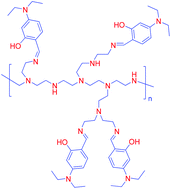Polymer-based biocompatible fluorescent sensor for nano-molar detection of Zn2+ in aqueous medium and biological samples†
Abstract
Chemosensors are prepared through condensation reactions between polymeric amines and three different aldehydes; the activities of the three products were evaluated in DMF–H2O (7 : 3, v/v) solvent system. Chemosensor 2c demonstrated selectivity for Zn2+ enhancement of the fluorescence intensity at 420 nm. Upon binding of 2c with Zn2+, an approximately 9 fold enhancement in fluorescence intensity was observed due to the combined effect of ESIPT, C![[double bond, length as m-dash]](https://www.rsc.org/images/entities/char_e001.gif) N isomerisation and the two-channel quenching of PET. The investigation of the photophysical properties of 2c revealed that the sensor at low pH led to a shift in the emission profile because of the presence of two types of nitrogen i.e. sp2 and sp3 nitrogens and the pH dependent fluorescence profile is due to the protonation at sp3 hybridised nitrogen that influences the charge transfer transitions of 2c. However, the salt effect has not much influence on the photophysical properties of 2c; and 2c was found to form organic nano-particles (ONP) in a DMF–H2O (1 : 99, v/v) solvent system and this material was found to detect a minimum of 40 nM concentration of Zn2+. The receptor 2c was found to be biocompatible through MTT assay and potent to detect Zn2+ in real biological conditions of microbial cells. The compounds 2a, 2b and 2c while immobilized in PVC based membrane, exhibited their selectivity for zinc ions as ion selective electrodes. These electrodes responded linearly in a wide concentration range with a lower detection limit of 10 μM. The electrodes have been successfully used as indicator electrodes in potentiometric titration of zinc ions with EDTA.
N isomerisation and the two-channel quenching of PET. The investigation of the photophysical properties of 2c revealed that the sensor at low pH led to a shift in the emission profile because of the presence of two types of nitrogen i.e. sp2 and sp3 nitrogens and the pH dependent fluorescence profile is due to the protonation at sp3 hybridised nitrogen that influences the charge transfer transitions of 2c. However, the salt effect has not much influence on the photophysical properties of 2c; and 2c was found to form organic nano-particles (ONP) in a DMF–H2O (1 : 99, v/v) solvent system and this material was found to detect a minimum of 40 nM concentration of Zn2+. The receptor 2c was found to be biocompatible through MTT assay and potent to detect Zn2+ in real biological conditions of microbial cells. The compounds 2a, 2b and 2c while immobilized in PVC based membrane, exhibited their selectivity for zinc ions as ion selective electrodes. These electrodes responded linearly in a wide concentration range with a lower detection limit of 10 μM. The electrodes have been successfully used as indicator electrodes in potentiometric titration of zinc ions with EDTA.


 Please wait while we load your content...
Please wait while we load your content...